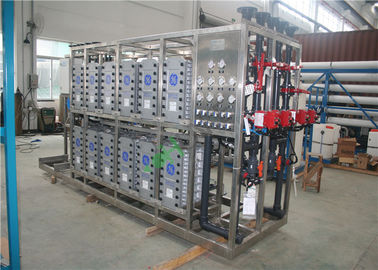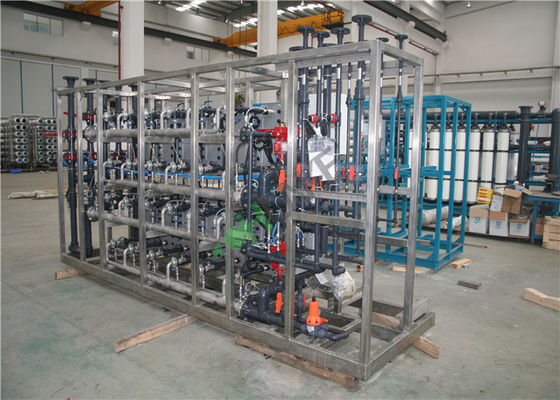Portable Mobile EDI Water Plant Containerized Seawater Desalination Plant
Product Description
RO EDI (Reverse Osmosis Electrodeionization) is the most preferred water purification technology used in Pharmaceutical and Food and beverage laboratories. It is basically a combination of Reverse Osmosis and Electrodeionization process. In a RO EDI System, single or double pass ro is used as pre-treatment of feed water, after that the water is further sent for electrodeionization, which generates highly purified water of 10-15 MΩ required in sensitive applications of research lab; in addition, this is also used for power plants and boiler water treatment.
RO EDI Plants, manufactured and installed by Bionics Advanced Filtration feature both safe and environment friendly performances at great price and produce better than distilled quality water. Depending upon feed water quality and flow rates, these units can produce between 10-15 MΩ pure water outputs. Depending upon customers' requirements, our RO EDI Plant units can be designed manual and completely automatic types fitted with PLC system.
The quality management system at Bionics Advanced Filtration has been registered to ISO 9001:2008; we welcome our customers to discuss their requirements of high-quality pure water required for their applications. Our engineering team is capable to design and construct the exact unit that meets or exceeds their quality requirements.
Benefits & Features
| Product water output up to 20000 LPH |
Produce high purity water of 10 to 15 MΩ |
| Guaranteed silica and boron removal (Optional) |
All VFD-driven pumps for precise control of all unit operations |
| Panel mounted resistivity meter with digital indication |
Panel mounted pressure and flow metering for the system |
| Reduced hazardous waste stream |
Overall recovery 100% of the system (approx.) |
| GMP/USP RO + EDI For Medicine |
According to ISPE regulations |
| Automatic sanitization, backwash, rinse, and recycle functions |
Completely skid mounted including pretreatment |
| Customizable for specific customer requirements |
Manual & automatic reverse osmosis system |
| Sanitary and non-sanitary designs available |
Intermediate stainless steel feed break tank |
| |
|
Typical Applications
| USP Purified Water |
Highly Purified Water |
| Pharmaceutical Preparations |
Biological Engineering |
| Central Laboratory Water |
Power Industry |
| Humidification |
Rinsing of Electronic Components |
| Glassware Rinsing |
Food processing |
| Preparation of Process Chemicals |
Cosmetics |
Technical Specifications
| Model No. |
Flow rate |
Pipe Size |
Pure Water Quality |
RO-EDI Module |
Dimensions(cm) |
| |
(L/h) Min |
(inch) |
(µS/cm) |
RO |
EDI |
H x W x D |
| Epure 220 |
220 |
3/4" |
1-10 |
1x40 |
1 |
1300 x 500 x 800 |
| Epure 450 |
450 |
3/4" |
1-10 |
2x40 |
1 |
1300 x 500 x 800 |
| Epure 1000 |
1000 |
3/4" |
1-10 |
5x40 |
1 |
1300 x 500 x 800 |
| Epure 1400 |
1400 |
3/4" |
1-10 |
6x40 |
1 |
1300 x 500 x 1000 |
| Epure 1800 |
1800 |
1" |
1-10 |
8x40 |
1 |
1300 x 500 x 1000 |
| Epure 3000 |
3000 |
1" |
1-10 |
4x80 |
1 |
1300 x 500 x 1200 |
| Epure 5000 |
5000 |
1" |
1-10 |
6x80 |
1 |
1300 x 500 x 1200 |
| Pressure Vessel |
Stainless Steel / Fiber Glass |
| Feed Water Requirements |
Water Hardness: 0.1 ppm Max.
Iron (Fe+++): 0.05 ppm Max.
Free Chlorine/Chloramine: 0.01 ppm Max.
Min. Inlet Pressure: 35 psi
Max. inlet pressure: 80 psi |
Min. Inlet Temperature: 45°F
Max. inlet temperature: 90°F
NOTE: Silica and carbonate content
in the feed water dictate the quality
of the water produced.18.3 MΩ |
| Accessories |
- Flow Meters
- Pressure gauges
- Conductivity monitor
- Reverse Osmosis Controller |
| Optional |
- Chemical dosing system
- UV sterilizer
- Ultrafiltration system
- Water Softener
- Built-in RO membrane washing device |
| Power |
Supply Single Phase 220 Volts / 3 Phase 410 Volts |
| Larger or custom systems available upon request |
FAQ
1. Q: What is reverse osmosis system?
A: Reverse osmosis is a hot topic in the water treatment industry. Reverse osmosis, is the process of osmosis backwards. Osmosis is the passage of water through a protein membrane (like our skin, or the inside of a plant cell) to equalize the concentration of particles dissolved in the water. The protein membrane allows water to pass through, but molecules larger than water (things like minerals, salts, and bacteria) cannot. Water flows back and forth until the concentration is equal on both sides of the membrane, and an equilibrium is formed.
Let's apply this knowledge to water purification. We want to drink water from a lake or stream, but it contains contaminants like salt, minerals, and bacteria, that make it undrinkable. By applying pressure to water as it passes through a membrane, the water can be forced to move away from the membrane rather than attempting to form an equilibrium like normal. This motion is where the "reverse" comes from. Water is forced through the membrane which blocks an extreme majority of contaminants from coming through.In water treatment, reverse osmosis can usually remove between 96 and 99% of most contaminants, including salts and minerals, dyes, particles, bacteria, and hazardous metals.
2. Q: How does it work?
A: Technical Ruote:
Raw tank-->raw water pump-->quartz sand filter-->activated carbon filter-->water softer-->
Sediment filter (cartridge filter 5um )-->high pressure pump-->RO desalination device-->permeate water tank
3. Q: What types of water sources does it treat?
A: Reverse Osmosis is an ideal water treatment solution in most types of water. Tap water, also known as municipal sources, underground water which includes brackish water, and saltwater. The biggest distinction between these three types is the Total Dissolved Solids (TDS) content of each type. As a rule of thumb, the American Health Association requires that drinking water is under 2,000 PPM TDS. Reverse osmosis is often used in a tap water environment to reduce hardness, or the debris deposited in water from traveling in metal pipes. TDS is often a target of water purification in tap water systems. Underground reservoirs of water are often brackish, meaning they contain large volumes of salt, but not enough to be considered salt water. Groundwater is most often purified for the agriculture industry, the mining industry. Groundwater is also a prized target of the bottling industry, because the unique mineral combinations often have an appealing taste.
Salt water reverse osmosis (sometimes referred to as desalination) is the turning of saltwater into drinking water. Ocean water has up to 45,000 PPM TDS. The biggest uses of desalination come in providing water in areas that lack a regular supply of fresh water.
4. Q: Is the pretreatment necessary?
A: It is very important that feed water be preconditioned to protect the membranes from fouling causing premature failure.The membrane is constructed of a porous material that allows water to pass through, but rejects up to 99% of the dissolved solids at the surface. The dissolved salts are concentrated reject water (brine stream), where they are discharged to waste. Removing things prior is key to letting the RO system do what it was meant to do. As the RO System continues to operate, the dissolved and suspended solids in the feed water tend to accumulate along the membrane surface. If these solids are allowed to build up, they eventually restrict the passage of water through the membranes, resulting in a loss of throughput. (The throughput capacity of the membranes is commonly referred to as the flux rate, and is measured in gallons per square foot of membranes surface area per day.)
5. Q: What determines the precise pretreatment for a particular RO?
A: In one word, analysis, because every source of water is different, and you never know what's in your water until you have it analyzed. The water analysis, LSI, SDI, or CFI values are used to determine the precise pretreatment requirements for a particular RO System. Since water supplies vary considerably from one location to another, each pretreatment requirement will be different.
6. Q:Does the feed water need to be softened by the RO?
A: Ion exchange is a popular method for softening and reducing the potential for mineral scale formation on the membrane surface. Ion exchange softening uses sodium to replace scaleforming ions such as calcium, magnesium, barium, strontium, iron, and aluminum to prevent damage to the membrane elements. The sodium forms very soluble salts, which are readily rejected by the Reverse Osmosis System and do not readily form mineral scales on the membrane surface. A sodiumcycle softener is regenerated with sodium chloride brine. The spent regenerant, along with the softener rinse water, must be discharged to waste. It is because of this that ion exchange is recommended for applications that have high metal contents in the treated water.
7. Q: what’s the basic information should provide for quotation?
A: 1) raw water and TDS of raw water; 2) the outlet water requirements, and also the usage; 3) capacity customer need.
8. Other details information, please kindly contact us any time.
Detail Pictures



 Your message must be between 20-3,000 characters!
Your message must be between 20-3,000 characters! Please check your E-mail!
Please check your E-mail!  Your message must be between 20-3,000 characters!
Your message must be between 20-3,000 characters! Please check your E-mail!
Please check your E-mail!






